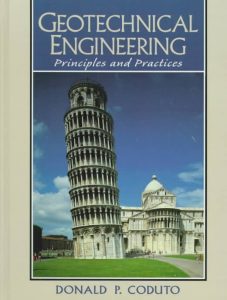
Geotechnical Engineering: Principles and Practices by Donald P. Coduto
Foundation Design and Construction has long been established as the most comprehensive and authoritative guide to the subject. The combination of soil engineering principles, design information, and construction details, makes this book an essential resource for undergraduates and practitioners alike. The text first introduces basic theory and then, by means of case studies, practical worked examples and design charts, develops an in-depth understanding of foundation design and construction methods. Types of foundation covered include shallow strip, pad and raft, basement structures, driven and bored piles, and deep shafts. Practical information is also given on foundation design for swelling and shrinking clays, filled ground and mining subsidence areas. In addition the text contains a useful introduction to computer-aided design.The seventh edition has been brought up-to-date with recent developments in foundation design and construction techniques.These include recent research undertaken by the Construction Industry Research and Development Association (CIRIA) leading to new methods and design rules, and a discussion of the requirements for the latest draft of Eurocode 7: Geotechnical Design.
Rigorous and technically deep — yet accessible — this up-to-date introduction to geotechnical engineering explores both the principles of soil mechanics and their application to engineering practice — emphasizing the role of geotechnical engineering in real design projects. An accompanying CD provides supplementary software developed specifically for learning purposes — e.g., SETTRATE. Discusses site exploration and characterization; soil composition; soil classification; excavation, grading, and compacted fill; groundwater — fundamentals and applications; stress; compressibility and settlement; rate of consolidation; strength; stability of earth slope; dams and levees; lateral earth pressures and retaining walls; structural foundations; difficult soils; soil improvement; and geotechnical earthquake engineering. Makes extensive use of photographs and example problems. For geotechnical engineers, soils engineers, ground engineers, structural engineers, and civil engineers.


 Visit
Visit 